|
Peugeot 308
Debut: 2007
Maker: Peugeot
Predecessor: 307 |
|
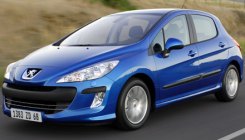 Following the
death of Peugeot 307, we
can conclude that it was a successful car – with 3 million copies sold
in 6 years and always at the top 3 of its segment in Europe – but it
wasn't as successful as Peugeot hoped for. The firm originally aimed at
beating Volkswagen Golf with the 307. It didn't quite do that because
it was simply not as good as Golf V. Peugeot 307 was supposed to be a
versatile car, but its MPV-style tall body did not bring any merits to
interior space but only compromising handling and ride quality. To
driving enthusiasts, it was a disappointment after the memorable 306.
Fortunately, now its position is substituted by a better car, 308. Following the
death of Peugeot 307, we
can conclude that it was a successful car – with 3 million copies sold
in 6 years and always at the top 3 of its segment in Europe – but it
wasn't as successful as Peugeot hoped for. The firm originally aimed at
beating Volkswagen Golf with the 307. It didn't quite do that because
it was simply not as good as Golf V. Peugeot 307 was supposed to be a
versatile car, but its MPV-style tall body did not bring any merits to
interior space but only compromising handling and ride quality. To
driving enthusiasts, it was a disappointment after the memorable 306.
Fortunately, now its position is substituted by a better car, 308.
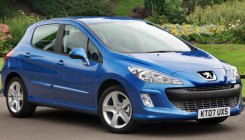 At the first glance, you might be displeased that the new
308 employs an evolution of the 307 platform. Everything is
predictable: it rides on the same wheelbase, the same MacPherson struts
as front suspensions and semi-independent torsion beam at the rear. The
steering is assisted by electro-hydraulic, which means the hydraulic
pump is driven by electric motor, while the servo circuit is purely
hydraulic. The body is longer (+74mm), much wider (+85mm) and much much
heavier (+162kg for the 1.6-liter model) than the old car. On the
positive side, the roof now stands 1498mm above the ground, some 12mm
lower than before, if still tall by class standard. Don't worry, as the
car is also wider than the norm (at 1815mm versus 1759mm of Golf), the
negative effect of higher center of gravity is virtually non-existent.
The new chassis is also 10 percent stiffer than 307. Drag coefficient
is slightly lower at 0.30-0.31, depending on engine and tire width. At the first glance, you might be displeased that the new
308 employs an evolution of the 307 platform. Everything is
predictable: it rides on the same wheelbase, the same MacPherson struts
as front suspensions and semi-independent torsion beam at the rear. The
steering is assisted by electro-hydraulic, which means the hydraulic
pump is driven by electric motor, while the servo circuit is purely
hydraulic. The body is longer (+74mm), much wider (+85mm) and much much
heavier (+162kg for the 1.6-liter model) than the old car. On the
positive side, the roof now stands 1498mm above the ground, some 12mm
lower than before, if still tall by class standard. Don't worry, as the
car is also wider than the norm (at 1815mm versus 1759mm of Golf), the
negative effect of higher center of gravity is virtually non-existent.
The new chassis is also 10 percent stiffer than 307. Drag coefficient
is slightly lower at 0.30-0.31, depending on engine and tire width.
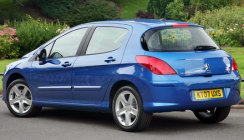 Peugeot's recent designs have been expressive to the extent
of exaggerating. 308 is no exception. With a big mouth, pronounced nose
and aggressive eyes, it looks interestingly like the lion in its logo -
what a contrast to the conservative 307 ! However, I would prefer the
handsome yet restrained styling of 306. Peugeot should understand that
they are not designing a sports car but a family car. It should please
as many people as possible and retain high residual values after a
period of time. Look at Volkswagen Golf and you will understand what
"design with disciplines" means. Peugeot's recent designs have been expressive to the extent
of exaggerating. 308 is no exception. With a big mouth, pronounced nose
and aggressive eyes, it looks interestingly like the lion in its logo -
what a contrast to the conservative 307 ! However, I would prefer the
handsome yet restrained styling of 306. Peugeot should understand that
they are not designing a sports car but a family car. It should please
as many people as possible and retain high residual values after a
period of time. Look at Volkswagen Golf and you will understand what
"design with disciplines" means.
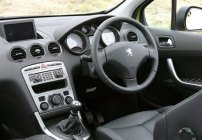 While
the look of 308 is not in everybody's taste, the interior is on the
contrary. This year there are 2 French cars' interior really make us
wow, one is Renault Laguna III, another is this one. The 308's cabin is
not only tastefully shaped and decorated with chromed details, but also
made of soft-touch plastics and assembled with the solidity previously
only available to Volkswagen. The overall sense of quality even exceeds
that of the Golf and just everybody else at the moment. In addition to
the full length panoramic glass roof – a classy feature of Peugeot
since 206 – the cabin feels airy and upmarket. In terms of space, the
308 has abundance of them up front. Rear space is decent rather than
class-leading, but the slimmer front backrests free up some vital
legroom for the rear passengers. Moreover, the high roof allows the
rear seat to be mounted higher than the front, thus the rear passengers
should feel roomier than actual. While
the look of 308 is not in everybody's taste, the interior is on the
contrary. This year there are 2 French cars' interior really make us
wow, one is Renault Laguna III, another is this one. The 308's cabin is
not only tastefully shaped and decorated with chromed details, but also
made of soft-touch plastics and assembled with the solidity previously
only available to Volkswagen. The overall sense of quality even exceeds
that of the Golf and just everybody else at the moment. In addition to
the full length panoramic glass roof – a classy feature of Peugeot
since 206 – the cabin feels airy and upmarket. In terms of space, the
308 has abundance of them up front. Rear space is decent rather than
class-leading, but the slimmer front backrests free up some vital
legroom for the rear passengers. Moreover, the high roof allows the
rear seat to be mounted higher than the front, thus the rear passengers
should feel roomier than actual.
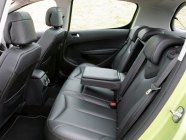 Open the bonnet, lying there is
BMW's 1.6-liter 16V VVT
Valvetronic engine or its non-Valvetronic but direct-injected and
turbocharged version. They produce 120 horsepower and 150 horsepower
respectively. To cope with the hefty car, our choice is the turbo
engine, of course, because it produces plenty of mid-range torque to
overcome the 1327 kg kerb weight. In contrast, the naturally aspirated
version needs to be revved hard and therefore noisier most of the time.
You can forget the base BMW 1.4-liter 95hp VVT engine. It's better to
leave it for Mini One. That said, all of the BMW engines are leagues
ahead of the previous generation of PSA engines. They are more punchy,
refined and efficient simultaneously, voilà ! Open the bonnet, lying there is
BMW's 1.6-liter 16V VVT
Valvetronic engine or its non-Valvetronic but direct-injected and
turbocharged version. They produce 120 horsepower and 150 horsepower
respectively. To cope with the hefty car, our choice is the turbo
engine, of course, because it produces plenty of mid-range torque to
overcome the 1327 kg kerb weight. In contrast, the naturally aspirated
version needs to be revved hard and therefore noisier most of the time.
You can forget the base BMW 1.4-liter 95hp VVT engine. It's better to
leave it for Mini One. That said, all of the BMW engines are leagues
ahead of the previous generation of PSA engines. They are more punchy,
refined and efficient simultaneously, voilà !
Diesel lovers could choose from PSA's own engines, including 90hp
1.6HDi, 110hp 1.6HDi and 136hp 2.0HDi, but there is little reasons to
choose them instead of the petrol. Even the top diesel won't deliver
the same level of smoothness, quietness and performance as the petrol
1.6 Turbo. The only upside is better fuel economy, but even the
petrol's 39.7 mpg is not bad !
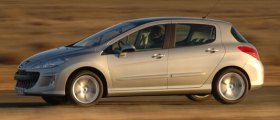 As 308 is a heavy car, unless you tick the 1.6 Turbo
engine, it is not going to trouble Golf and Focus for performance. But
just as you wonder where its extra weight comes from, it responds with
excellent noise insulation, a quiet and supple ride. This is the most
comfortable car in the class. It reminds us the best tradition of
French cars. It skips the genes of 307 and recaptures the absorbent
ride quality of 306. The suspension setting is softer than the Germanic
school of Golf and Focus (especially the Ford), therefore it doesn't
control its body roll as tight, but the 308 is still a very competent
driving machine. Its steering is communicative, perfectly weighted and
accurate. This allows it to slice through corners precisely and
confidently. As 308 is a heavy car, unless you tick the 1.6 Turbo
engine, it is not going to trouble Golf and Focus for performance. But
just as you wonder where its extra weight comes from, it responds with
excellent noise insulation, a quiet and supple ride. This is the most
comfortable car in the class. It reminds us the best tradition of
French cars. It skips the genes of 307 and recaptures the absorbent
ride quality of 306. The suspension setting is softer than the Germanic
school of Golf and Focus (especially the Ford), therefore it doesn't
control its body roll as tight, but the 308 is still a very competent
driving machine. Its steering is communicative, perfectly weighted and
accurate. This allows it to slice through corners precisely and
confidently.
How Peugeot managed this high level of integrity between handling and
ride comfort is unimaginable, especially considering it doesn't have
the sophisticated rear suspensions as its rivals. Perhaps Peugeot has
really recaptured its magical technique of suspension tuning. The fact
that the recent 407, 207 and this car display excellent handling and
ride does not just happen by chance. There must be some clever people
and philosophy behind the scene.
Car by car, we can say the 308 1.6THP deserves higher praise than its
rivals. Its good engine, high-quality cabin, excellent comfort and
refinement, superb ride quality and fine handling send warning signals
to Golf and Focus. Its weaknesses are the extra weight (somewhat
politically incorrect these years), weaker performance on other engines
and the exaggerating looks. A Golf still looks more desirable and
dependable, but the Peugeot should be a nightmare to Focus.
|
| The
above report was last updated on 5 Sep 2007. All
Rights Reserved. |
308 GT
|
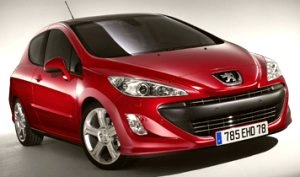
|
Its extra power and roadholding allows
occasional fun, but it is by no means a true Peugeot hot hatch...
|
If
you think Peugeot 308 GT is the successor of the mighty 306 GTI (S16),
you will be wrong. These days Peugeot is no longer eager to place
driving excitement above everything else. Instead, it trades some
excitement for comfort, safety and practicality. So what you see here
is a "warm hatch" powered by an eco-friendly small turbocharged engine,
the same unit as that serving Mini Cooper S and Peugeot 207RC. 1.6
liters of capacity is boosted by a twin-scroll turbocharger and
assisted with direct fuel injection and continuous intake variable
valve timing to produce some 175 horsepower at 6000 rpm. Max torque 180
lb-ft is delivered in a flexible way, from 1600 rpm to 4500 rpm. Should
that be not enough, an overboost allows another 15 lb-ft for
overtaking. However, compare with those 200+ horsepower GTI, the
Peugeot 308 range-topper is only lukewarm. 140 mph top speed and 7.9
seconds for 0-60 mph are hardly thrilling these days. Unfortunately,
PSA said it has no plans to make a hotter version in the foreseeable
future.
Fans of 306 GTI, your all-time great will have a secured status for
some more years !
If you accept the idea of warm hatch, you may find 308 GT likable.
Although the BMW engine offers little excitement in how it revs and
sings, its flexible torque is highly usable in town and regular
driving. It is pretty frugal too - EU combined consumption is 37 mpg,
only 2 mpg lower than the smaller 207 RC. This is partly thanks to the
use of a 6-speed manual gearbox, in contrast to the 5-speeder in 207
RC.
Tweaks to the chassis is pretty mild - slightly stiffer springs and
dampers, 10 mm lower ride height, quicker steering rack and 18-inch
alloy wheels shod with 225/40 rubbers. It retains much of the superb
ride comfort of the 308 range while delivering better body control and
grip. Sharp handling ? no, it won't match those real hot hatches like
Golf GTI. There is too much body roll in corners to discourage you to
press on. Stiffer suspensions could solve the problem, but then again
it won't deliver the ride comfort that Peugeot want. On the positive
side, the electro-hydraulic steering transmits true information from
the
front wheels to your hands.
The 308 GT is a high-quality and practical car for everyday use. Its
extra power and roadholding allows occasional fun, but it is by no
means a true Peugeot hot hatch. |
| The
above report was last updated on 3 May 2008. All
Rights Reserved. |
308 CC
|
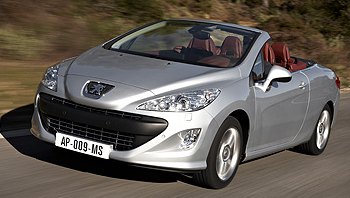
|
308CC is the coupe-cabriolet leader's
second try to break into this segment...
|
Coupe-cabriolet
is a kind of car that we both love and hate. On the one hand we love
the good insulation from noise and vibration brought by its stiff
structure. We like its superior weather protection and sense of
security. We enjoy the envy sights attracted by its robotic up and down
operation. On the other hand we don't like the roof mechanism occupies
a lot of luggage space. We can't put up with its small back seats
either. We dislike the resultant long boot which usually ruins the
styling. Finally, we hate the additional weight that blunts performance
and handling.
No coupe-cabriolet can escape from these disadvantages. The question is
only how much they minimize the disadvantages. Until now Volkswagen Eos
has shown the best effort in the C-segment coupe-cabriolet crowd. Opel
Astra TwinTop is also a credible choice. Not so good are Ford Focus CC,
the outgoing Renault Megane CC and Peugeot 307CC. Strangely, Peugeot is
the trend setter as well as the largest manufacturer of coupe-cabriolet
in the world. However, its success is mostly down to the entry-level
206 and 207CC. When it came to the larger 307CC, it left a lot to be
desired - looks, build quality, refinement and dynamics. Now the
renewal to 308CC gives it a good chance to strike back...
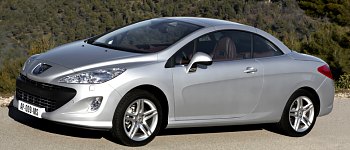
|
The roof still consists of 2 metal
panels, versus rivals' three...
|
The
first sight at 308CC will find it a vast improvement from its
predecessor. Not only more stylish, not only its large tail is better
integrated, it is also very well made. As in other 308s, the interior
is impressive for style, build quality and expensive materials - soft
plastics match piano-black decor. The leather bucket seats offer
Mercedes-Airscarf-style hot air ventilation to warm your neck so that
you can enjoy open motoring in winter. Look at the price tag and option
lists, you will get the idea that Peugeot wants to stretch its soil
towards German premium manufacturer.
Next, we try the folding metal roof. It folds or expands in 20 seconds,
and you can operate it at speed up to 12 km/h, not necessarily at a
complete stop. A bit disappointing, however, is that it still consists
of 2 metal panels, versus the 3-piece items on Eos and Astra. This mean
the horizontal section of the roof is smaller than its rivals, thus
both the windscreen and rear screen are more sharply angled. As a
result, the front seat occupants find the windscreen header very close
to their heads and hurt the sense of openness, while rear seat
passengers will find very tight head room. They will also find legroom
limited. In fact, 308CC is more 2+2 than a real 4-seater, no matter
what Peugeot said. On the up side, the car offers good luggage space
measuring 465 liters with the roof up or 266 liters with the roof
stored.
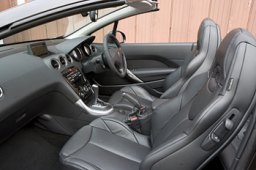
|
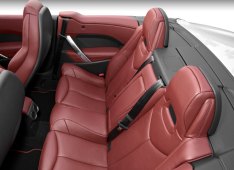
|
Luxurious cabin seats 4... well, 2+2...
|
Benefited
by an increase of 8 percent in chassis rigidity, the 308CC offers the
refinement you would expect in a modern CC. Scuttle shake is noticeable
only on bad roads. Wind management and noise insulation are also up to
the job. The ride and handling setting is about middle of the road,
neither disappoints nor surprises. Like other coupe-cabriolets, it
doesn't like to be pushed to the extreme.
The biggest problem is performance. Those roof mechanism and chassis
strengthening put an extra 185 kilograms to the weight of an equivalent
308 hatchback. This should be compensated with a more powerful engine.
Unfortunately, Peugeot offers 4 underpowered units - 120hp 1.6VTi,
150hp 1.6THP, 110hp 1.6HDi and 140hp 2.0HDi - and skips the hatchback's
175hp 1.6THP. While these motors are refined and frugal, they work very
hard yet fail to give decent performance. Even the top 150hp engine
would take more than 9 seconds to do 0-60 mph run, some 2 seconds
longer than Volkswagen Eos equipped with 200hp 2.0TSI engine. That's
day and night difference for a car.
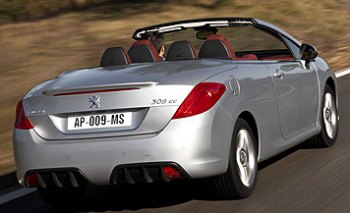
|
Large tail is better integrated into
the design...
|
That
said, Peugeot knows very well that the majority sales of
coupe-cabriolets go to cheaper engine choices. Without offering a
powerful engine actually hurts little its sales. It just prevents 308CC
from matching Volkswagen Eos in the eyes of keen drivers. But then
again, would keen drivers buy coupe-cabriolets ? |
| The
above report was last updated on 23 May
2009. All Rights Reserved. |
|
|